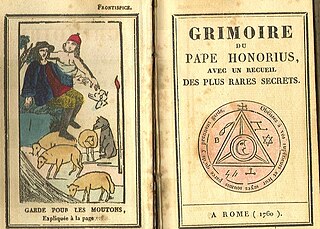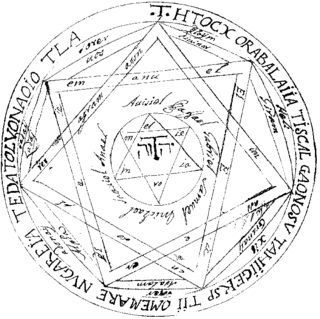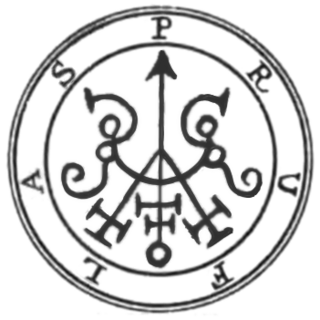 W
WA grimoire is a textbook of magic, typically including instructions on how to create magical objects like talismans and amulets, how to perform magical spells, charms and divination, and how to summon or invoke supernatural entities such as angels, spirits, deities and demons. In many cases, the books themselves are believed to be imbued with magical powers, although in many cultures, other sacred texts that are not grimoires have been believed to have supernatural properties intrinsically. The only contents found in a grimoire would be information on spells, rituals, the preparation of magical tools, and lists of ingredients and their magical correspondence. In this manner, while all books on magic could be thought of as grimoires, not all magical books should be thought of as grimoires.
 W
WAradia, or the Gospel of the Witches is a book composed by the American folklorist Charles Godfrey Leland that was published in 1899. It contains what he believed was the religious text of a group of pagan witches in Tuscany, Italy that documented their beliefs and rituals, although various historians and folklorists have disputed the existence of such a group. In the 20th century, the book was very influential in the development of the contemporary Pagan religion of Wicca.
 W
WThe Black Pullet also known in French as “la poule aux œufs d’or” is a grimoire that proposes to teach the "science of magical talismans and rings", including the art of necromancy and Kabbalah. It is believed to have been written in the 18th century by an anonymous French officer who served in Napoleon's army. The text takes the form of a narrative centering on the French officer during the Egyptian expedition led by Napoleon when his unit is suddenly attacked by Arab soldiers (Bedouins). The French officer manages to escape the attack, but is the only survivor. An old Turkish man appears suddenly from the pyramids and takes the French officer into a secret apartment within one of the pyramids. He nurses him back to health whilst sharing with him the magical teachings from ancient manuscripts that escaped the "burning of Ptolemy's library".
 W
WThe Book of Protection: Being a Collection of Charms is a collection of Eastern Christian charms and incantations associated with the so-called 'Nestorian' Church, edited and translated by Hermann Gollancz from three Syriac manuscripts which date back to early 19th century and earlier. The compilation was first published in 1912 by Henry Frowde, with 27 illustrations from Codex A.
 W
WA Book of Shadows is a book containing religious text and instructions for magical rituals found within the Neopagan religion of Wicca, and in many pagan practices. One famous Book of Shadows was created by the pioneering Wiccan Gerald Gardner sometime in the late 1940s or early 1950s, and which he utilised first in his Bricket Wood coven and then in other covens which he founded in following decades. The Book of Shadows is also used by other Wiccan traditions, such as Alexandrianism and Mohsianism, and with the rise of books teaching people how to begin following Wicca in the 1970s onward, the idea of the Book of Shadows was then further propagated amongst solitary practitioners unconnected to earlier traditions.
 W
WThe Book of Abramelin tells the story of an Egyptian mage named Abraham, or Abra-Melin, who taught a system of magic to Abraham of Worms, a Jew in Worms, Germany, presumed to have lived from c.1362–c.1458. The system of magic from this book regained popularity in the 19th and 20th centuries partly due to Samuel Liddell MacGregor Mathers' translation, The Book of the Sacred Magic of Abramelin the Mage; and partly to its importance within the Hermetic Order of the Golden Dawn, and later within the mystical system of Thelema.
 W
WThe Grand Albert is a grimoire that has often been attributed to Albertus Magnus. Begun perhaps around 1245, it received its definitive form in Latin around 1493, a French translation in 1500, and its most expansive and well-known French edition in 1703. Its original Latin title, Liber Secretorum Alberti Magni virtutibus herbarum, lapidum and animalium quorumdam, translates to English as "the book of secrets of Albert the Great on the virtues of herbs, stones and certain animals". It is also known under the names of The Secrets of Albert, Secreta Alberti, and Experimenta Alberti.
 W
WThe Grand Grimoire is a black magic grimoire. Different editions date the book to 1521, 1522 or 1421, but it was probably written in the early 19th century. Owen Davies suggests 1702 is when the first edition may have created and a Bibliothèque bleue version of the text may have been published in 1750. The "introductory chapter" was authored by someone named Antonio Venitiana del Rabina who supposedly gathered this information from original writings of King Solomon. Much of material in this grimoire derives from the Key of Solomon and the Lesser Key of Solomon. Also known as Le Dragon Rouge or The Red Dragon, this book contains instructions purported to summon Lucifer or Lucifuge Rofocale, for the purpose of forming a Deal with the Devil. The 19th century French occultist Éliphas Lévi believed the contemporary edition of Le Dragon Rouge to be counterfeit of the true, older Grand Grimoire.
 W
WThe Book of Saint Cyprian refers to different grimoires from the 17th, 18th, and 19th centuries, all pseudepigraphically attributed to the 3rd century Saint Cyprian of Antioch. According to popular legend, Cyprian of Antioch was a pagan sorcerer who converted to Christianity.
 W
WThe Greek Magical Papyri is the name given by scholars to a body of papyri from Graeco-Roman Egypt, written mostly in ancient Greek, which each contain a number of magical spells, formulae, hymns, and rituals. The materials in the papyri date from the 100s BCE to the 400s CE. The manuscripts came to light through the antiquities trade, from the 1700s onward. One of the best known of these texts is the Mithras Liturgy.
 W
WThe Hermetica are the philosophical texts attributed to the legendary Hellenistic figure Hermes Trismegistus. These texts may vary widely in content and purpose, but are usually subdivided into two main categories:The "technical" Hermetica: this category contains treatises dealing with astrology, medicine and pharmacology, alchemy, and magic, the oldest of which were written in Greek and may go back as far as to the second or third century BCE. Many of the texts belonging to this category were later translated into Arabic and Latin, often being extensively revised and expanded throughout the centuries. Some of them were also originally written in Arabic, though in many cases their status as an original work or translation remains unclear. These Arabic and Latin Hermetic texts were widely copied throughout the Middle Ages. The "philosophical" Hermetica: this category contains religio-philosophical treatises which were mostly written in the second and third centuries CE, though the very earliest of them may go back to the first century CE. They are chiefly focused on the relationship between human beings, the cosmos, and God, and on moral exhortations calling for a way of life leading to spiritual rebirth, and eventually to apotheosis in the form of a heavenly ascent. The treatises in this category were probably all originally written in Greek, even though some of them only survive in Coptic, Armenian, or Latin translations. During the Middle Ages, most of them were only accessible to Byzantine scholars, until a compilation of Greek Hermetic treatises known as the Corpus Hermeticum was translated into Latin by the Renaissance scholars Marsilio Ficino (1433–1499) and Lodovico Lazzarelli (1447–1500).
 W
WThe Grimoire of Pope Honorius, or Le Grimoire du Pape Honorius, is a 17th to 18th century grimoire, claiming to be written by Pope Honorius III. It is unique among grimoires in that it was specifically designed to be used by a priest, and some of the instructions include saying a Mass. While its name is derived from the 13th century Grimoire of Honorius, its content is closer to later grimories like the Key of Solomon and Grimorium Verum.
 W
WThe Key of Solomon is a pseudepigraphical grimoire attributed to King Solomon. It probably dates back to the 14th or 15th century Italian Renaissance. It presents a typical example of Renaissance magic.
 W
WPetit Albert is an 18th-century grimoire of natural and cabalistic magic. The Petit Albert is possibly inspired by the writings of Albertus Parvus Lucius Brought down to the smallest hamlets in the saddlebags of peddlers, it represents a phenomenal publishing success, despite its association with "devil worshippers"—or rather thanks to it. It is associated with a second work, the Grand Albert. It is a composite, even heterogeneous work, and perhaps a bric-a-brac, collecting texts of unequal value written by various authors; most of these authors are anonymous, but some are notable such as Cardano and Paracelsus. It is a relatively old text, in which even the attribution to Albertus Magnus is dubious. Coupled with the fact that it quotes from so many later sources, this makes it an ethnological document of the first order.
 W
WPicatrix is the name used today for a 400-page book of magic and astrology originally written in Arabic under the title Ghāyat al-Ḥakīm, which most scholars assume was originally written in the middle of the 11th century, though an argument for composition in the first half of the 10th century has been made. The Arabic title translates as The Aim of the Sage or The Goal of The Wise. The Arabic work was translated into Spanish and then into Latin during the 13th century, at which time it got the Latin title Picatrix. The book's title Picatrix is also sometimes used to refer to the book's author.
 W
WPseudomonarchia Daemonum, or False Monarchy of Demons, first appears as an Appendix to De praestigiis daemonum (1577) by Johann Weyer. An abridgment of a grimoire similar in nature to the Ars Goetia, it contains a list of demons, and the appropriate hours and rituals to conjure them.
 W
WSefer Raziel HaMalakh,, is a grimoire of Practical Kabbalah from the Middle Ages written primarily in Hebrew and Aramaic. The Liber Razielis Archangeli, its 13th-century Latin translation produced under Alfonso X, survives.
 W
WShams al-Ma'arif or Shams al-Ma'arif wa Lata'if al-'Awarif is a 13th-century grimoire written on Arabic magic and a manual for achieving esoteric spirituality. It was written by The Algerian scholar Ahmad al-Buni who wrote it while living in Ayyubid Egypt, he died around 1225 CE. The Shams al-Ma'arif is generally regarded as the most influential textbook of its type in the Arab world, and is arguably as important as, if not more than, the Picatrix in both hemispheres.
 W
WThe Simon Necronomicon is a grimoire written by an unknown author, with an introduction by a man identified only as "Simon". Materials presented in the book are a blend of ancient Middle Eastern elements, with allusions to the writings of H. P. Lovecraft and Aleister Crowley, woven together with a story about a man known as the "Mad Arab".
 W
WThe Sixth and Seventh Books of Moses is an 18th- or 19th-century magical text allegedly written by Moses, and passed down as hidden books of the Hebrew Bible. Self-described as "the wonderful arts of the old Hebrews, taken from the Mosaic books of the Kabbalah and the Talmud," it is actually a grimoire, or text of magical incantations and seals, that purports to instruct the reader in the spells used to create some of the miracles portrayed in the Bible as well as to grant other forms of good fortune and good health. The work contains reputed Talmudic magic names, words, and ideograms, some written in Hebrew and some with letters from the Latin alphabet. It contains "Seals" or magical drawings accompanied by instructions intended to help the user perform various tasks, from controlling weather or people to contacting the dead or Biblical religious figures.
 W
WThe Triangular Book of St. Germain or The Triangular Manuscript is an untitled 18th-century French text written in code, and attributed to the legendary Count of St. Germain. It takes its name from its physical shape: the binding and sheets of vellum that comprise the manuscript are in the shape of an equilateral triangle. The text, once deciphered, details a magical operation through which a person can perform feats of magic, notably the discovery of treasure and extension of life.
 W
WThree Books of Occult Philosophy is Heinrich Cornelius Agrippa's study of occult philosophy, acknowledged as a significant contribution to the Renaissance philosophical discussion concerning the powers of magic, and its relationship with religion. The first book was printed in 1531 in Paris, Cologne, and Antwerp, while the full three volumes first appeared in Cologne in 1533.